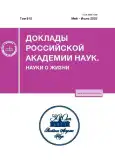THE FIRST DATA ON THE NUTRITION OF THE URAL CAVE BEAR (MAMMALIA, CARNIVORA, URSIDAE, URSUS (SPELAEARCTOS) KANIVETZ VERESTCHAGIN, 1973) BASED ON THE RESULTS OF THE ANALYSIS OF ISOTOPES 13C and 15N
- Authors: Kosintsev P.A.1, Simonova G.V.2, Konovalova K.Y.1
-
Affiliations:
- Institute of Plant and Animal Ecology, Ural Branch, Russian Academy of Sciences
- Institute of Monitoring of Climatic and Ecological Systems Siberian Branch, Russian Academy of Sciences
- Issue: Vol 510, No 1 (2023)
- Pages: 288-291
- Section: Articles
- URL: https://journals.rcsi.science/2686-7389/article/view/135699
- DOI: https://doi.org/10.31857/S2686738922601084
- EDN: https://elibrary.ru/QHGAIW
- ID: 135699
Cite item
Full Text
Abstract
The first data on the content of isotopes 13C and 15N in the collagen of 16 bones of the Ural cave bear (Ursus (Spelaearctos) kanivetz Verestchagin, 1973) were obtained from the Tayn (Secrets) cave (55°25' N, 57°46' E). The bones date from the middle of MIS 3. The bones of males and females aged about 2 years, about 3 years and older than 4 years were studied. There are no noticeable differences in isotope signatures between individuals of different ages and different sexes. Since the second year of life, cave bears have been eating plant food on their own. The values of δ13C and δ15N of the Ural cave bear are close to the values for U. (S.) spelaeus ingressus.
Keywords
About the authors
P. A. Kosintsev
Institute of Plant and Animal Ecology, Ural Branch, Russian Academy of Sciences
Author for correspondence.
Email: kpa@ipae.uran.ru
Russian Federation, Yekaterinburg
G. V. Simonova
Institute of Monitoring of Climatic and Ecological Systems Siberian Branch, Russian Academy of Sciences
Email: kpa@ipae.uran.ru
Russian Federation,
Tomsk
K. Yu. Konovalova
Institute of Plant and Animal Ecology, Ural Branch, Russian Academy of Sciences
Email: kpa@ipae.uran.ru
Russian Federation, Yekaterinburg
References
- Bocherens H. Isotopic insights on cave bear palaeodiet // Historical Biology. 2019. V. 31. № 4. P. 410–421.
- Robu M., Fortin J.K., Richards M.P., et al. Isotopic evidence for dietary flexibility among European Late Pleistocene cave bears (Ursus spelaeus) // Canadian Journal of Zoology. 2013. V. 91. № 4. P. 227–234.
- Bocherens H., Stiller M., Hobson K.A., et al. Niche partitioning between two sympatric genetically distinct cave bears (Ursus spelaeus and Ursus ingressus) and brown bear (Ursus arctos) from Austria: Isotopic evidence from fossil bones // Quaternary International. 2011. V. 245. № 2. P. 238–248.
- Bon C., Berthonaud V., Fosse P., et al. Low regional diversity of late cave bears mitochondrial DNA at the time of Chauvet Aurignacian paintings // Journal of Archaeological Science. 2011. V. 38. № 8. P. 1886–1895.
- Pérez-Rama M., Fernández-Mosquera D., Grandal-d’Anglade A. Recognizing Growth Patterns and Maternal Strategies in Extinct Species Using Stable Isotopes: The Case of the Cave Bear Ursus spelaeus ROSENMÜLLER // Quaternary International. 2011. V. 245. № 2. P. 302–306.
- Münzel S.C., Stiller M., Hofreiter M., et al. Pleistocene Bears in the Swabian Jura (Germany): Genetic replacement, ecological displacement, extinctions and survival // Quaternary International. 2011. V. 245. № 2. P. 225–237.
- Nejman L., Wood R., Wright D., et al. Hominid Visitation of the Moravian Karst during the Middle-Upper Paleolithic Transition: New Results from Pod Hradem Cave (Czech Republic) // Journal of Human Evolution. 2017. V. 108. P. 131–146.
- Gimranov D., Bocherens H., Kavcik-Graumann N., et al. The cave bears from Imanay Cave (Southern Urals, Russia). Historical Biology. 2022. V. 34 (4).
- Barlow A., Paijmans J.L.A., Federica A., et al. Middle Pleistocene genome calibrates a revised evolutionary history of extinct cave bears // Current Biology. 2021. V. 31. № 8. P. 1771–1779.
- Гимранов Д.О., Косинцев П.А. Пещерные медведи (Ursus spelaeus sensu lato) Урала // Палеонтологический журнал. 2022. № 1. С. 97–106.
- Stiller M., Molak M., Prost S. et al. Mitochondrial DNA diversity and evolution of the Pleistocene cave bear complex // Quaternary International. 2014. V. 339–340. P. 224–231.
- Горбунова А.К., Андрейчук В.Н., Костарев В.П., и др. Карст и пещеры Пермской области. Пермь: Изд-во Пермского университета; 1992. С. 200.
- Косинцев П.А., Воробьев А.А. Биология большого пещерного медведя (Ursus spelaeus Ros. et Hein.) на Урале. Ю.А. Розанов (ред.). В кн.: Мамонт и его окружение: 200 лет изучения. М.: Геос; 2001. С. 266–278.
- Pacher M., Stuart A.J. Extinction chronology and palaeobiology of the cave bear (Ursus spelaeus) // Boreas. 2009. V. 38. P. 189–206.
- Kosintsev P.A., Gasilin V.V., Gimranov D.O., et al. Carnivores of the Ural in the late Pleistocene and Holocene // Quaternary International. 2016. V. 420. P. 145–155.
- Воробьев А.А. Этапы постнатального онтогенеза скелета большого пещерного медведя // Биота горных территорий: История и соврем. состояние: Материалы конференции молодых ученых; 15–19 апреля 2002 г. Екатеринбург: Академкнига; 2002. С. 22–28.
- Воробьев А.А. Размеры длинных трубчатых костей большого пещерного медведя Среднего Урала // Современные проблемы популяционной, исторической и прикладной экологии: Материалы конференции. молодых ученых; 23–27 апреля 2001. Екатеринбург: “Екатеринбург”; 2001. С. 38–41.
- Fosse P., Cregut-Bonnoure E. Ontogeny/growth of (sub)modern brown bear (Ursus arctos) skeleton: A guideline to appraise seasonality for cave bear (Ursus spelaeus) sites? // Quaternary International. 2014. V. 339–340. P. 275–288.
- Лебедев А.Т. Масс-спектрометрия для анализа объектов окружающей среды. Москва: Техносфера; 2013. С. 632.
- Bocherens H., Drucker D. Trophic level isotopic enrichment of carbon and nitrogen in bone collagen: case studies from recent and ancient terrestrial ecosystems // International J. of Osteoarchaeol. 2003. V. 13. № 1/2. P. 46–53.
Supplementary files











